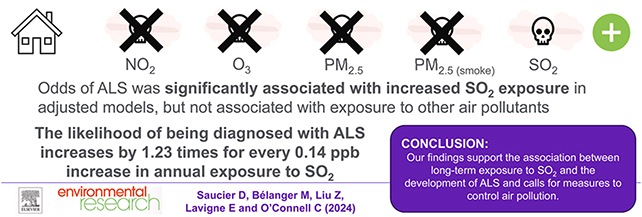A component of fossil fuel emissions could contribute to an increased risk of the neurodegenerative disease ALS (amyotrophic lateral sclerosis), according to a new study.
Researchers in Canada matched 304 people diagnosed with ALS with 1,207 healthy people of the same age and sex. They estimated each individual's exposure to pollutants based on environmental records on the location of their primary residence.
In particular, the researchers compared measures of sulfur dioxide (SO2), a compound produced by the combustion of coal and oil-based fuels. Previously linked to brain damage, the pollutant had not been studied in relation to ALS.
Related: Your Hairstyle Could Generate Pollution on Par With Busy Traffic
The researchers found that those diagnosed with ALS in their sample had "a significantly higher history" of SO2 exposure than the controls.
While the association doesn't prove direct cause and effect, it's a strong link and a worrying finding – especially as all the areas covered by the study were well within the official guidelines for 'clean' air quality.
"Our findings support the association between long-term exposure to air pollutants, particularly sulfur dioxide, and the development of ALS, supporting the need for improved air pollution control measures," write the researchers in their published paper.

Nitrogen dioxide (NO2) – also a by-product of car fumes and coal-fired power stations – has previously been linked to ALS risk, but this analysis didn't show any meaningful association after adjusting for other factors (including socioeconomic factors).
The team found that levels of sulfur dioxide prior to symptoms appearing were far more critical than measures taken in years before a diagnosis, suggesting individuals were often at a 'point of no return' by the time they were evaluated by medical specialists.
"This is the first study to highlight that higher levels of ambient SO2 in residential areas relate to an increased risk of ALS," write the researchers.
While ALS remains rare, with around 1 to 2 new cases per 100,000 people per year reported worldwide, its effects are devastating. The condition gradually destroys nerve cells to cause paralysis, and in the majority of cases is fatal within three years.
Scientists are continuing to discover more about ALS, but its cause is yet to be determined – there's typically no family history of the condition, for instance. Risk factors, including physical exercise and genetic mutations, have been identified, but overall, the picture isn't a clear one.
It's likely that a combination of factors combine to put the necessary mechanisms in motion, and from this and other studies, it seems probable that air pollution is among them. Of course, we also know that the same smog of modern living has also been linked to lung cancer and poor mental health, among other issues.
The researchers behind this latest study are keen to see further investigations into the effects of pollutants on ALS risk, and suggest that air quality regulations should be tighter – even as fossil fuels continue to burn.
"There is a necessity for prevention strategies and improved regulatory intervention on behalf of public health on air pollution exposure levels," write the researchers.
The research has been published in Environmental Research.
